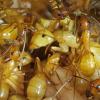9-15-18
On September 14th, I collected four workers of Formica montana from colonies nearly a mile apart in Waukesha, WI. I collected them all separately in 150x16mm test tubes. Two workers were collected from each colony.
The cotton blocker was taken off of both test tubes and they were connected until no space lie in between the two test tube entrances. As soon as the workers were in the same test tube, the vacant tube was replaced with a test tube with the cotton slightly pushed in to create a space where the workers are closer together. They did not come in contact then. Once in the new test tube, it was sealed off and the ants came in contact for the first time.
The first contact was a slight threatening stance from one of the workers, and then both broke off and moved away. The second contact had no aggression, and the ants almost initiated Trophallaxis. The third contact, the ants showed no aggression again and initiated trophallaxis. There was no fight or aggression whatsoever.
The experiment was repeated once again and the same results were shown, yet at a slower pace with the two workers avoiding each other for a short period of time.
Once the experiments were completed, all workers were released at the nearest colony. Within five minutes, all workers had peacefully entered the nest.
This shows evidence that there could be supercolonies in the populations of Formica montana.
Along with the workers being tolerated in foreign nests and treated as a member of the colony, I have not observed any flights from these colonies or even any wandering queens in the area. This supports my theory.
There’s much more work to be done and I plan to do more research and document it on this thread.
Edited by AnthonyP163, September 15 2018 - 2:32 PM.




















